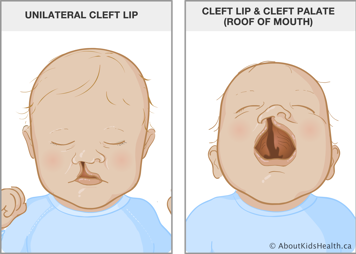In the first trimester of pregnancy, components that make up the lip and palate fuse together. If these parts do not fuse properly, a space called a cleft develops. Clefts can vary in type and severity. Clefts of the lip and palate are common, occurring in about one in 1,000 births. Most babies with cleft lip or cleft palate are otherwise healthy. Some babies who have clefts may also have other medical problems.
Cleft lip and palate are examples of a congenital anomaly, which is a structural or functional disorder in a baby that is present from birth.
Cleft lip
Cleft lip is a separation in the upper lip. Cleft lip can occur if certain parts of the nose and upper jaw do not fuse properly during the early weeks of pregnancy. Cleft lip can vary in severity from a slight notch in the lip to a complete separation of the lip running up to the nose and back to the gum line.
Cleft palate
Cleft palate is a separation in the middle of the palate. Cleft palate can form if the roof of the mouth and the floor of the nasal cavity do not fuse properly in early pregnancy. Cleft palate can range in severity from a tiny opening at the back of the palate to a large gap in the roof of the mouth.

Impact of cleft lip and palate
Most babies with cleft lip and palate are diagnosed at birth. The diagnosis and the medical needs of their baby can be shocking or overwhelming to parents. Many babies with cleft lip and palate are referred to a specialized team that can support the family throughout the baby’s medical journey.
Aside from its cosmetic effect, cleft lip and palate can present challenges for a baby, including problems with feeding, hearing, dental development and speech.
Feeding
It may be difficult for a baby with cleft lip or palate to suck or feed. An occupational therapist or speech and language pathologist can help give parents tips on how to make the feeding process easier, including using a specialized nipple and bottle.
Hearing
Cleft palate can sometimes affect the middle ear and therefore interfere with a child’s hearing. Fluid can build up in the middle ear, causing temporary hearing loss or recurrent ear infections. Sometimes, tubes may need to be inserted to drain the fluid from the ear.
Teeth
Cleft lip or palate can affect a child’s teeth. The baby may have missing or extra teeth, small teeth or crooked teeth. Some babies need orthodontic treatment to bring the parts of the upper jaw, lips and nose into better position. Orthodontic treatment helps to improve the results of cleft surgery.
Speech
The palate is important for normal speech development. Many children need speech therapy after cleft palate is repaired.
Treatment of cleft lip and cleft palate
All babies with cleft lip or cleft palate need to see a plastic surgeon within the first week or two after birth. Surgery differs from child to child because every newborn baby’s cleft is different. The plastic surgeon will go over what surgical techniques your child will need.
